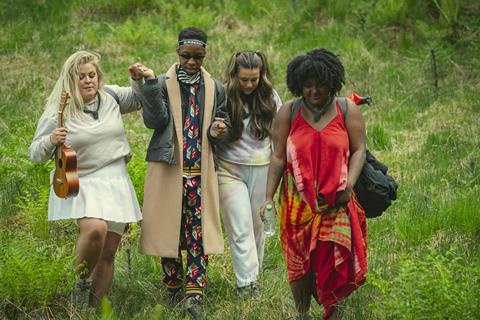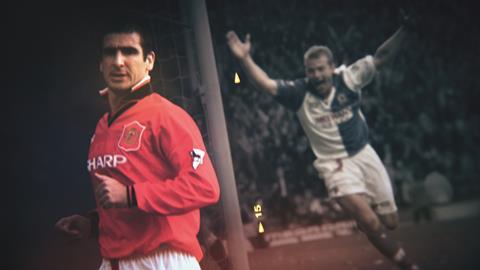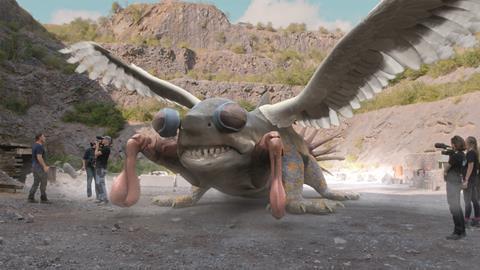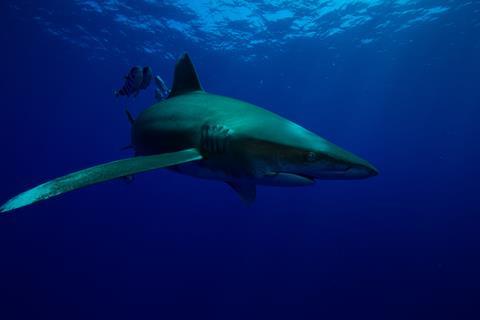This 8 X 40-minute Netflix reality series, which puts a group of young adults in the wilderness, was finished in HDR and 5.1 audio.
Fifty Fifty head of creative DI and senior colourist Joe Stabb says the key challenge in creating a series look for the grade was the unpredictability of the weather: “I spent time with the team at Naked and Netflix to develop a selection of creative and technical looks, and it was decided a summer vibe would be a key objective.”
The HDR grade enabled Stabb to pull out key colours using Baselight’s HDR tools. He deepened the luminance of selected hues to make the series look fun and appeal to a younger audience.
The project included matte paintings, comps, captions, Boris Sapphire flares and transitions, which were reconstructed and temporarily added to the Baselight scene for client viewing. They were then reapplied in the Flame suite downstream.
For the online edit, executive post producer Shiv Meeda says, Fifty Fifty brought in additional Flame suites, editors and assists for the project, which was led by online editor and flame artist Roisin. She says: “I worked with the online, VFX and grade departments, managing an overview across editorial notes from review sessions and VFX sign-offs at both a technical and editorial level.”
When it came to the sound, head of audio Gavin Allingham mixed in 5.1 using Pro Tools Ultimate with the Avid S6. He kept the mix punchy, with music driving scenes and lots of transition effects.
He says: “We had been provided with Ambisonic wild tracks of each location, which are 360-degree recordings that were de-coded into 5.1 using the SoundField by Rode plug-in. These really helped give a better sense of the environment the contributors were in.”
THE MAN WHO FELL TO EARTH
PRODUCTION CBS Studios, Secret Hideout & Timberman-Beverly Productions
VFX One of Us
WATCH IT Paramount+
One of Us created more than 100 VFX shots for this Showtime/Paramount+ series. The studio’s main work is in episode one, when an alien crash-lands on Earth, climbs out of the impact crater, and grows a skinsuit to disguise himself as a human.
For the scene, VFX supervisor Rupert Davies and 2D supervisor Andy Tusabe developed a visual style based on a blend of Nasa photography. Tusabe says: “As a child, I always had a fascination for Nasa images. Being able to bring them to life was an amazing experience.”
The team tackled the space sequence exclusively with 2D tools, which they say was an “unusual and creatively rewarding experience”. The result is a painterly, ethereal look.
For the reveal of the alien in the scene, CG supervisor Andrea Falcone says the client initially shot some footage inside the set, which was a recreation of a 20-ft deep limestone-rockshaft.
This was the starting point for the VFX work. Falcone explains: “What was initially just a set extension, to make the live set rock shaft deeper, developed into a fully CG sequence. We replaced the whole environment, the practical effects and the actor in most shots.”
The rockshaft required a detailed CG build. Once the team realised they were replacing the whole environment, the CG artists took the opportunity to make it a lot more exciting, adding molten rock, debris and atmospheric effects.
For the alien’s skinsuit, One of Us worked in Houdini FX in collaboration with the FX, lighting and comp artists.
Another sequence One of Us worked on, which the team called ‘Josiah’, starts when the protagonist enters a room with a dying man in a menacing way before shutting the door behind them. “It looks like he is going to kill him as he grabs the other guy by the throat,” says Tusabe. “But then it’s clear he is actually healing him when you see the energy flowing from his eyes, curing the illness, represented as a black cancer.”
The scene required a lot of tracking to represent the veins in the skin and all the glowing lights. Some CG elements were used to create the internal anatomy.
SUPER GREED: THE FIGHT FOR FOOTBALL
PRODUCTION Fulwell 73
GRAPHICS Blue Spill
WATCH IT Sky
This doc tells the story of the rise and fall of the European Super League, over a 48-hour period from the initial press release about the plans.
Director Carl Hindmarch wanted the film tonally to feel like a cinematic espionage thriller that would unveil the true intentions of the people responsible. Blue Spill created an overall style for the graphics, which lent in to this aesthetic, and a range of graphical sequences, from photograph and document treatments to statistical graphic explainers.
Sequences were created to feel like classified documents being exposed. These were embellished graphically with handwritten notes to create a sense of journalistic search and collection of puzzle pieces coming together.
As an extra visual layer, Blue Spill weaved in elements of football iconography, such as club badges, to incorporate the aesthetic of the game into this confidential world. The title sequence focused on the history of football and its fans – from its birth all the way up to this super-greed moment.
DEADLY PREDATORS
PRODUCTION BBC Studios
POST-PRODUCTION Doghouse
WATCH IT CBBC
For the latest strand of CBBC’s Deadly series, Doghouse was tasked with all aspects of post-production, including VFX, motion graphics, sound and finishing post.
The series was filmed across the UK and Doghouse creative director Fred Tay joined the crew on VFX supervision duty. He ensured the CG sequences worked for the team and provided presenter Steve Backshall with the correct eye-lines using AR references on set.
Each episode spent three weeks in the offline, using temporary guides for the CGI, before entering finishing post. The VFX brought the animals to life, showing their size and the skillset that makes them deadly.
For the final episode, an amalgamation of the deadliest elements of all six featured predators was created. This Frankenstein creature was called The Ultimate Predator.
Archive footage was heavily used, so ensuring a consistent grade throughout the series was key. The online, completed on Adobe Premiere, also ensured continuity from the offline to delivery, keeping the stylistic elements and transitions unique to the Deadly strand.
PLANET SHARK
PRODUCTION Big Wave
POST-PRODUCTION The Edit
WATCH IT National Geographic
National Geographic’s HDR series Planet Shark uses stunning underwater photography and cutting-edge science to discover what is it about sharks that makes them such successful survivors.
The Edit provided colour grading on the 3 x 60-minute episodes, which was carried out by colourists Dave Austin and Joshua Cordell. It was their first HDR project, and Austin says: “Big Wave did an amazing job of shooting and sourcing the most extraordinary shark footage ever seen.”
He adds: “Adapting to HDR felt natural and you don’t necessarily have to work as hard to make an image look good as you do in SDR, because there is more latitude.
“There’s a misconception that HDR programmes should be much brighter than SDR, but for me, HDR simply affords more headroom for highlight details, which adds up to a new level of realism. Of course, that’s not to say that you can’t make a scene dazzlingly bright if that fits the creative needs – but now it’s there as a choice.”
The series was directed by Mark Woodward at Big Wave and 5.1 audio was mixed by Andrew Wilson at Red Six.









